Suchergebnisse für "raspberry OR pi OR 3 OR basic OR to OR advanced OR projects"
-

Elektor Digital Raspberry Pi 3 – Basic to Advanced Projects (E-book)
This book is about the Raspberry Pi 3 computer and its use in various control and monitoring applications. The book explains in simple terms and with tested and working example projects, how to configure the Raspberry Pi 3 computer, how to install and use the Linux operating system, and how to write hardware based applications programs using the Python programming language. The nice feature of this book is that it covers many Raspberry Pi 3 based hardware projects using the latest hardware modules such as the Sense HAT, Swiss Pi, MotoPi, Camera module, and many other state of the art analog and digital sensors. An important feature of the Raspberry Pi 3 is that it contains on-board Bluetooth and Wi-Fi modules. Example projects are given in the book on using the Wi-Fi and the Bluetooth modules to show how real-data can be sent to the Cloud using the Wi-Fi module, and also how to communicate with an Android based mobile phone using the Bluetooth module. The book is ideal for self-study, and is intended for electronic/electrical engineering students, practising engineers, research students, and for hobbyists. It is recommended that the book should be followed in the given Chapter order. Over 30 projects are given in the book. All the projects in the book are based on the Python programming language and they have been fully tested. Full program listings of every project are given in the book with comments and full descriptions. Experienced programmers should find it easy to modify and update the programs to suit their needs. The following sub-headings are given for each project to make it as easy as possible for the readers to follow the projects: Project title Description Aim of the project Raspberry Pi type Block diagram Circuit diagram Program listing
€ 29,95
Mitglieder € 23,96
-
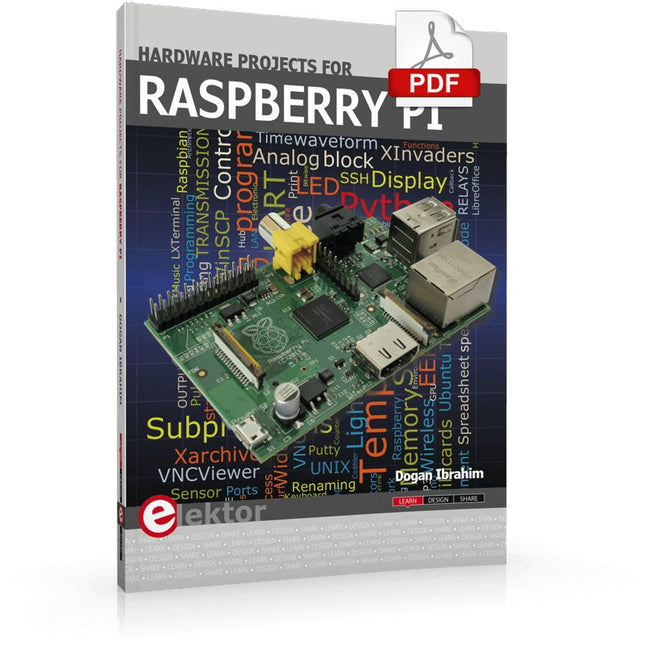
Elektor Digital Hardware Projects for Raspberry Pi (E-book)
The Raspberry Pi is a $35 credit-card sized computer with many applications, such as in desktop computing, audio and video playback, and as a controller in many industrial, commercial and domestic applications. This book is about the Raspberry Pi computer and its use in control applications. The book explains in simple terms, with examples, how to configure the RPi, how to install and use the Linux operating system, how to write programs using the Python programming language and how to develop hardware based projects. The book starts with an introduction to the Raspberry Pi computer and covers the topics of purchasing all the necessary equipment and installing/using the Linux operating system in command mode. Use of the user-friendly graphical desktop operating environment is explained using example applications. The RPi network interface is explained in simple steps and demonstrates how the computer can be accessed remotely from a desktop or a laptop computer. The remaining parts of the book cover the Python programming language, hardware development tools, hardware interface details, and RPi based hardware projects. All the 23 projects given in the book have been tested and are working. The following headings are given for each project: Project title Project description Project block diagram Project circuit diagram Project program description using the Program Description Language (PDL) Complete program listing Description of the program The book is ideal for self-study, and is intended for electronic/electrical engineering students, practising engineers, research students, and hobbyists.
€ 34,95
Mitglieder € 27,96
-
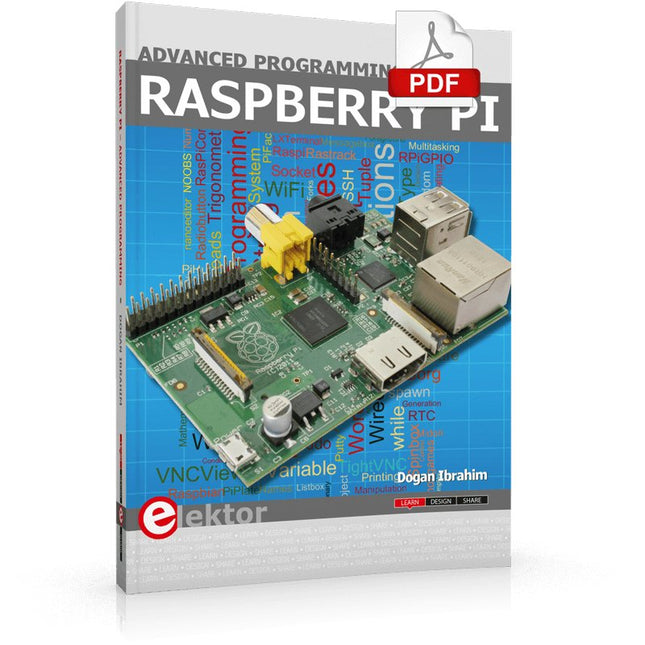
Elektor Digital Raspberry Pi Advanced Programming (E-book)
This book is about advanced programming of the Raspberry Pi computer using the Python programming language. The book explains in simple terms and with examples: How to configure the Raspberry Pi computer; How to install and use the Linux operating system and the desktop; How to write advanced programs using the Python programming language; How to use graphics in our programs; How to develop hardware based projects using the Raspberry Pi. The book starts with an introduction to the Raspberry Pi computer and covers the topics of purchasing all the necessary accessories and installing and operating the Linux operating system in command mode. The network interface of the RPi is explained in simple steps, demonstrating how the computer can be accessed remotely from a desktop or a laptop computer. The remaining parts of the book cover the Python programming language in detail, including advanced topics such as operating system calls, multitasking, interprocess synchronization and interprocess communication techniques. The important topic of network programming using UDP and TCP protocols is described with working examples. The Tkinter graphical user interface module (GUI) is described in detail with example widgets and programs. The last part of the book includes hardware projects based on using the advanced programming topics such as multitasking and interprocess communication techniques. All the projects given in the book have been fully tested and are working. Complete program listings of all projects are provided with detailed explanations.
€ 34,95
Mitglieder € 27,96
-
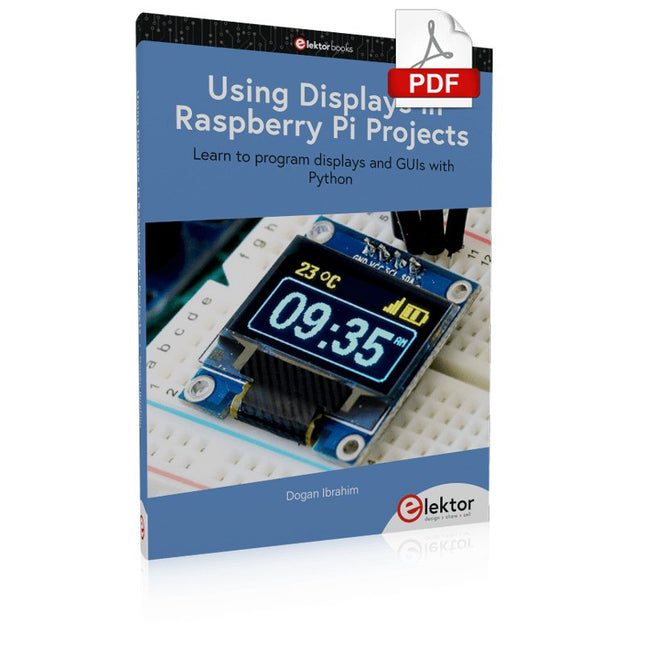
Elektor Digital Using Displays in Raspberry Pi Projects (E-book)
Learn to program displays and GUIs with Python This book is about Raspberry Pi 4 display projects. The book starts by explaining how to install the latest Raspbian operating system on an SD card, and how to configure and use the GPIO ports. The core of the book explains the following topics in simple terms with fully tested and working example projects: Simple LED projects Bar graph LED projects Matrix LED projects Bitmap LED projects LED strips LCDs OLED displays E-paper displays TFT displays 7-inch touch screen GUI Programming with Tkinder One unique feature of this book is that it covers almost all types of display that readers will need to use in their Raspberry Pi based projects. The operation of each project is fully given, including block diagrams, circuit diagrams, and commented full program listings. It is therefore an easy task to convert the given projects to run on other popular platforms, such as Arduino or PIC microcontrollers. Python program listings of all Raspberry Pi projects developed in this book are available for download at Elektor.com. Readers can use these programs in their projects. Alternatively, they can modify the programs to suit their applications.
€ 32,95
Mitglieder € 26,36
-
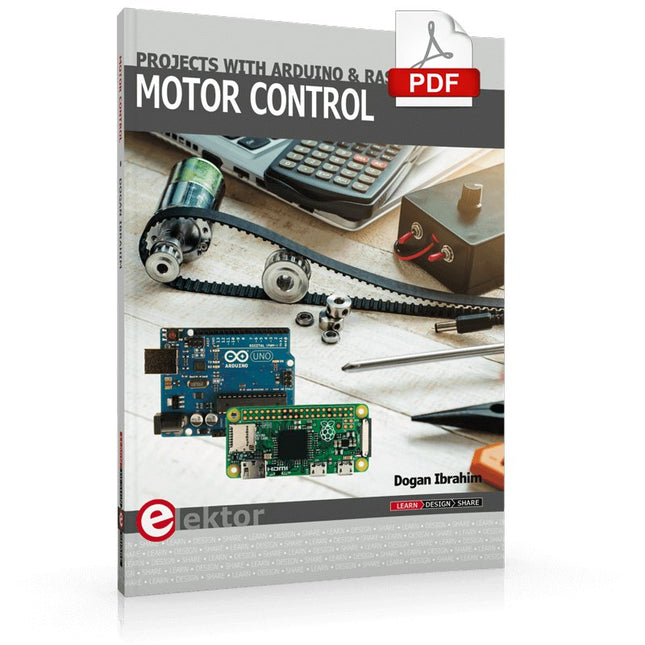
Elektor Digital Motor Control - Projects with Arduino & Raspberry Pi (E-book)
This book is about DC electric motors and their use in Arduino and Raspberry Pi Zero W based projects. The book includes many tested and working projects where each project has the following sub-headings: Title of the project Description of the project Block diagram Circuit diagram Project assembly Complete program listing of the project Full description of the program The projects in the book cover the standard DC motors, stepper motors, servo motors, and mobile robots. The book is aimed at students, hobbyists, and anyone else interested in developing microcontroller based projects using the Arduino Uno or the Raspberry Pi Zero W. One of the nice features of this book is that it gives complete projects for remote control of a mobile robot from a mobile phone, using the Arduino Uno as well as the Raspberry Pi Zero W development boards. These projects are developed using Wi-Fi as well as the Bluetooth connectivity with the mobile phone. Readers should be able to move a robot forward, reverse, turn left, or turn right by sending simple commands from a mobile phone. Full program listings of all the projects as well as the detailed program descriptions are given in the book. Users should be able to use the projects as they are presented, or modify them to suit to their own needs.
€ 29,95
Mitglieder € 23,96
-
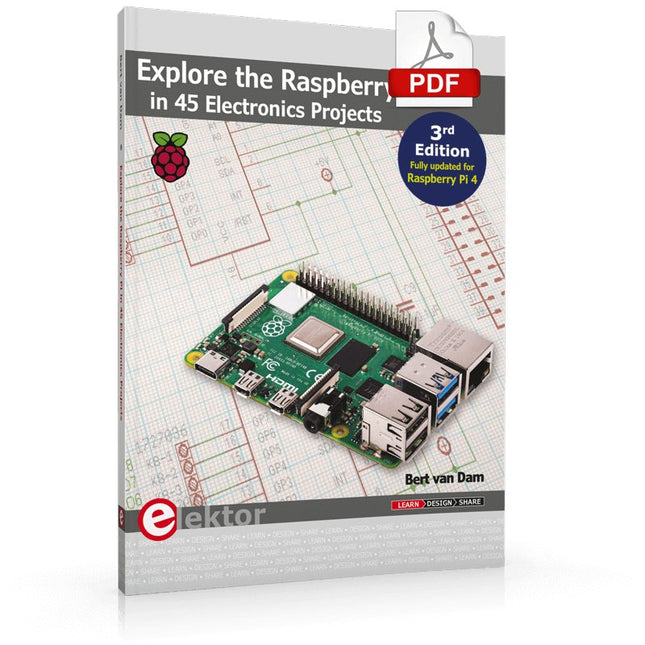
Elektor Digital Explore the Raspberry Pi in 45 Electronics Projects (3rd Edition | E-book)
3rd Edition – Fully updated for Raspberry Pi 4 The Raspberry Pi is a very cheap but complete computer system that allows all sorts of electronics parts and extensions to be connected. This book addresses one of the strongest aspects of the Raspberry Pi: the ability to combine hands-on electronics and programming. Combine hands-on electronics and programming After a short introduction to the Raspberry Pi you proceed with installing the required software. The SD card that can be purchased in conjunction with this book contains everything to get started with the Raspberry Pi. At the side of the (optional) Windows PC, software is used which is free for downloading. The book continues with a concise introduction to the Linux operating system, after which you start programming in Bash, Python 3 and Javascript. Although the emphasis is on Python, the coverage is brief and to the point in all cases – just enabling you to grasp the essence of all projects and start adapting them to your requirements. All set, you can carry on with fun projects. The book is ideal for self-study No fewer than 45 exciting and compelling projects are discussed and elaborated in detail. From a flashing lights to driving an electromotor; from processing and generating analog signals to a lux meter and a temperature control. We also move to more complex projects like a motor speed controller, a web server with CGI, client-server applications and Xwindows programs. Each project has details of the way it got designed that way The process of reading, building, and programming not only provides insight into the Raspberry Pi, Python, and the electronic parts used, but also enables you to modify or extend the projects any way you like. Also, feel free to combine several projects into a larger design.
€ 32,95
Mitglieder € 26,36
-

Raspberry Pi Foundation Raspberry Pi Build HAT
Bauen Sie robuste, intelligente Maschinen, die die Rechenleistung des Raspberry Pi mit LEGO-Komponenten kombinieren. Der Raspberry Pi Build HAT bietet vier Anschlüsse für LEGO Technic Motoren und Sensoren aus dem SPIKE Portfolio. Zu den verfügbaren Sensoren gehören ein Abstandssensor, ein Farbsensor und ein vielseitiger Kraftsensor. Die Winkelmotoren sind in verschiedenen Größen erhältlich und verfügen über integrierte Encoder, die ihre Position abfragen können. Der Build HAT passt auf alle Raspberry Pi-Computer mit einem 40-Pin-GPIO-Header, einschließlich – mit der Hinzufügung eines Flachbandkabels oder eines anderen Erweiterungsgeräts – Raspberry Pi 400. Angeschlossene LEGO Technic-Geräte können neben Standard-Raspberry-Pi-Zubehör problemlos in Python gesteuert werden wie zum Beispiel ein Kameramodul. Merkmale Steuert bis zu 4 Motoren und Sensoren Versorgt den Raspberry Pi mit Strom (bei Verwendung mit einem geeigneten externen Netzteil) Einfache Verwendung von Python auf dem Raspberry Pi
€ 29,95€ 14,95
Mitglieder identisch
-
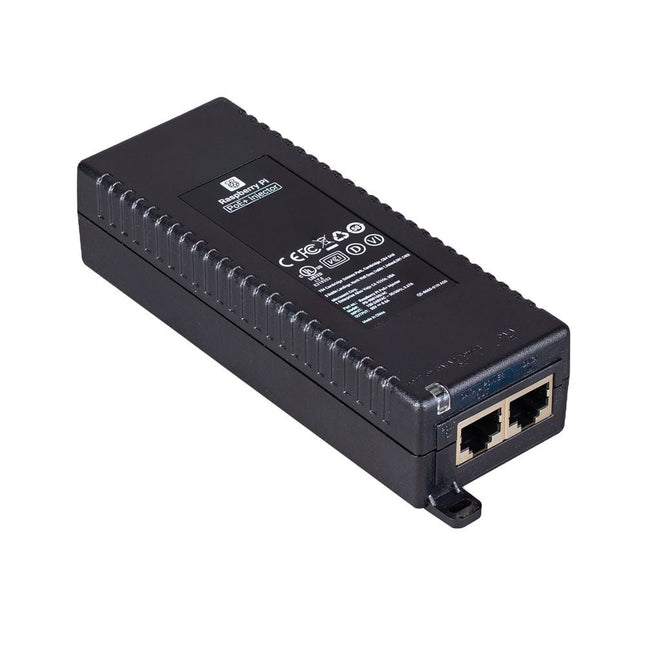
Raspberry Pi Foundation Raspberry Pi PoE+ Injector
Der Raspberry Pi PoE+ Injektor erweitert einen einzelnen Port eines Nicht-PoE-Ethernet-Switches um Power-over-Ethernet (PoE)-Funktionalität und überträgt Strom und Daten über ein einziges Ethernet-Kabel. Er bietet eine kostengünstige Plug-and-Play-Lösung für die schrittweise Einführung von PoE in bestehende Ethernet-Netzwerke. Der PoE+ Injektor ist ein 30-W-Gerät mit einem Port und eignet sich zur Stromversorgung von Geräten gemäß den Standards IEEE 802.3af und 802.3at, einschließlich aller Generationen von Raspberry Pi PoE HATs. Er unterstützt Netzwerk-Passthrough-Geschwindigkeiten von 10/100/1000 Mbit/s. Hinweis: Für den Betrieb ist ein separates IEC-Netzkabel erforderlich (nicht im Lieferumfang enthalten). Technische Daten Datenrate 10/100/1000 Mbit/s Eingangsspannung 100 bis 240 V AC Ausgangsleistung 30 W Leistungsabgabe an den Pins 4/5 (+), 7/8 (–) Nennausgangsspannung 55 V DC Datenanschlüsse Geschirmte RJ-45-, EIA 568A- und 568B Stromanschluss IEC C13-Netzeingang (nicht im Lieferumfang enthalten) Luftfeuchtigkeit bei Lagerung Maximal 95%, nicht kondensierend Betriebshöhe –300 m bis 3000 m Betriebsumgebungstemperatur 10°C bis +50°C Abmessungen 159 x 51,8 x 33,5 mm Downloads Datasheet
€ 29,95€ 14,95
Mitglieder identisch
-

Raspberry Pi Foundation Offizielles Gehäuse für Raspberry Pi 3 A+ (weiß/rot)
Das Raspberry Pi A+ Gehäuse wurde so konzipiert, dass es sowohl für den Pi 3 Model A+ als auch für den Pi 1 Model A+ passt. Die hochwertige ABS-Konstruktion besteht aus zwei Teilen. Die Basis verfügt über Aussparungen für den Zugriff auf die microSD-Karte und die HDMI-, Audio/Video- und USB-Anschlüsse sowie den Stromanschluss.
€ 6,95€ 3,50
Mitglieder identisch
-
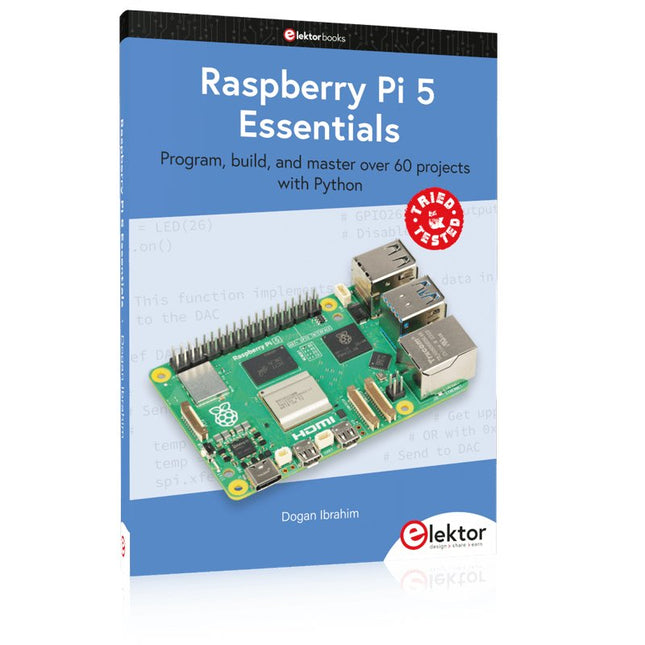
Elektor Publishing Raspberry Pi 5 Essentials
Program, build, and master over 60 projects with Python The Raspberry Pi 5 is the latest single-board computer from the Raspberry Pi Foundation. It can be used in many applications, such as in audio and video media centers, as a desktop computer, in industrial controllers, robotics, and in many domestic and commercial applications. In addition to the well-established features found in other Raspberry Pi computers, the Raspberry Pi 5 offers Wi-Fi and Bluetooth (classic and BLE), which makes it a perfect match for IoT as well as in remote and Internet-based control and monitoring applications. It is now possible to develop many real-time projects such as audio digital signal processing, real-time digital filtering, real-time digital control and monitoring, and many other real-time operations using this tiny powerhouse. The book starts with an introduction to the Raspberry Pi 5 computer and covers the important topics of accessing the computer locally and remotely. Use of the console language commands as well as accessing and using the desktop GUI are described with working examples. The remaining parts of the book cover many Raspberry Pi 5-based hardware projects using components and devices such as LEDs and buzzers LCDs Ultrasonic sensors Temperature and atmospheric pressure sensors The Sense HAT Camera modules Example projects are given using Wi-Fi and Bluetooth modules to send and receive data from smartphones and PCs, and sending real-time temperature and atmospheric pressure data to the cloud. All projects given in the book have been fully tested for correct operation. Only basic programming and electronics experience are required to follow the projects. Brief descriptions, block diagrams, detailed circuit diagrams, and full Python program listings are given for all projects described.
€ 39,95
Mitglieder € 35,96
-
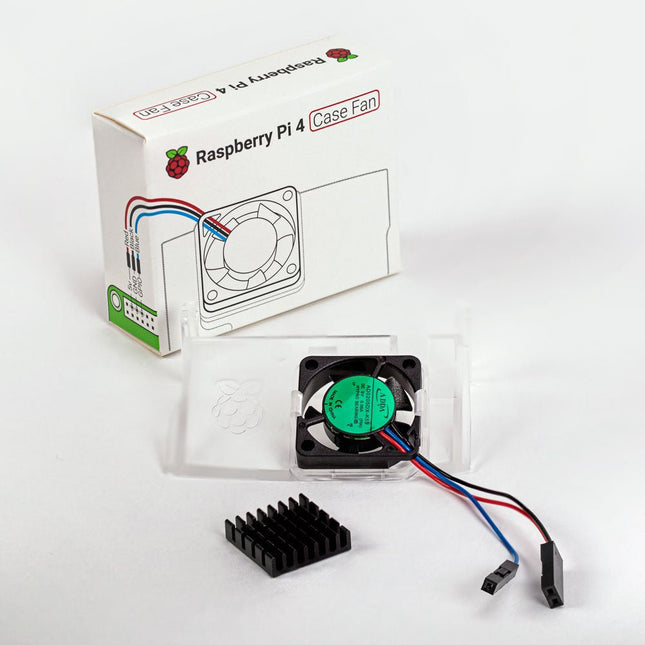
Raspberry Pi Foundation Raspberry Pi 4 Gehäuselüfter
Dieser Lüfter wurde für Übertakter und andere Power-User entwickelt und hält Ihren Raspberry Pi 4 auch unter starker Last auf einer angenehmen Betriebstemperatur. Der temperaturgesteuerte Lüfter liefert einen Luftstrom von bis zu 1,4 CFM über den Prozessor, den Speicher und den Energieverwaltungs-IC. Der mitgelieferte Kühlkörper (18 x 8 x 10 mm) mit selbstklebendem Pad verbessert die Wärmeübertragung vom Prozessor. Der Raspberry Pi 4 Gehäuselüfter funktioniert mit Raspberry Pi 4 und dem offiziellen Raspberry Pi 4 Gehäuse.
€ 6,95€ 3,50
Mitglieder identisch
-

, von Lobna Belarbi Elektors Raspberry Pi Bundles: Von Einsteiger-Sets bis zu fortgeschrittenen Kits
Finde das perfekte Raspberry Pi Bundle für dein Erfahrungsniveau Egal, ob du gerade erst in die Welt des Raspberry Pi eintauchst oder bereits anspruchsvolle Projekte...











